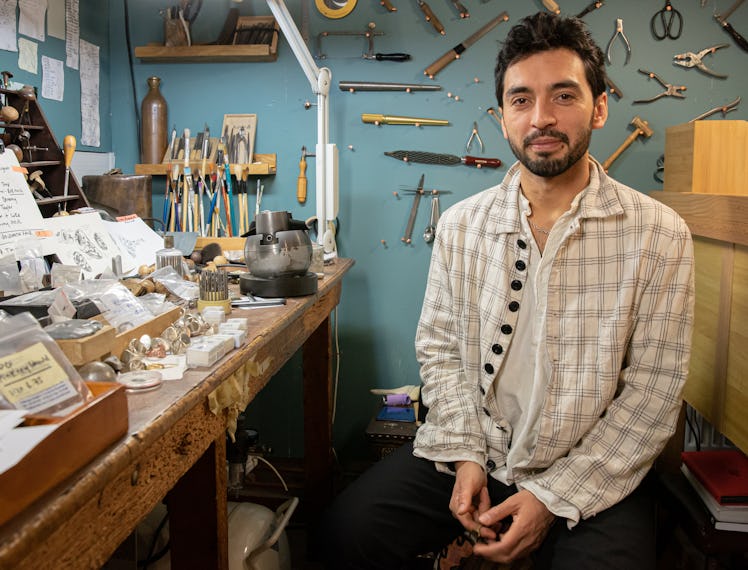The jeweler and engraver Castro Smith has made signet rings cool again. What were once considered family heirloom collector’s pieces are now must-have baubles—and Smith, who was first trained as an illustrator, printmaker and painter, is one of a legion of young designers reimagining the classic style.
“We never really set out to modernize the signet ring, “ said Smith during a recent Zoom call. “But for me, it was just a canvas. There are a lot of different facets to the ring and a lot of different areas. You have an image that can tell a story through different frames.”
The 32-year-old British jeweler’s schedule is filled with commissions by clients like The Queen’s Gambit star Anya Taylor-Joy, Daniel Day Lewis, and Elton John. But he’s also currently collaborating on a project with Valery Demure from Objet d’Emotion—he’ll create jewelry to showcase as part of a multi-sensory poetry exhibition, utilizing Charles Baudelaire’s Les Fleur du Mal poems to inform his designs.
“We’re looking at plants, nature, and love,” said Smith of his inspiration for the collection, which will bow in the fall. “We’re also looking at poisonous plants as well; I’m looking at folktales and I’m trying to create something new.”
Born and raised in Newcastle, England, Smith learned the technique of seal engraving when he took on a Goldsmith’s Company apprenticeship in Hatton Garden, London’s jewelry district. In 2017, he received the Winston Churchill Memorial Trust scholarship and studied in Japan with Japanese masters under Hiroshi Suzuki. He also worked and trained at Rebus and Tom Wood before launching his own brand in 2016. Smith was also among a group of artists working out of Alexander McQueen’s Sarabande Foundation and his workshop currently based at Cockpit Arts.
“It’s quite a cathartic process for the customers,” Smith said. “A lot of the time, it’s actually creating a solid piece they can wear that reflects some part of their heritage. Or perhaps it reminds them of their parents or a place. And for them, the process is so important.”
For his bespoke commissions, the client has an initial consultation with Castro at his workshop in London. “We talk to the customers directly,” he added. “They tell us ideas and stories and I’ll talk to them about what they’d like to engrave. People want to remember certain things: identity, where they’re from. There’s a lot of talking and a process of sharing—sometimes intimate information or dreams.”
Smith then sketches out the ideas generating in the meeting, and once the client confirms the style, they start creating the ring by fashioning the piece to the right size, in the desired metal. Then the ring is carved by hand. Smith utilizes a seal engraving technique which dates back 5,000 years: the seal is etched in reverse with a deeper finish than the traditional method.
The jeweler produces about 120 rings a year, he said—and any purchase of a Castro Smith ring includes the sketches. He sells his jewelry through individual commissions and at Dover Street Market—but Tayloy-Joy came straight to him to commission a piece of jewelry.
“She came to visit the studio and we talked about different ideas,” said Smith. “She had so many. We looked at old rings that we’ve made before and tried to get across different stories, different kinds of aesthetics. For this piece, we looked at hand positions in Victorian paintings. We wanted something a little bit creepy. We're working with flowers again and looking at the way in which they kind of defend and harm.”
Alongside his private commissions that he is working on currently, he will showcase his works at Cockpit Arts Open Studios from June 24th to 27th in London. He will also take part in the Goldsmiths Fair, which runs from September 28 to October 10, and highlights the works by silversmiths of over 130 emerging designers as well as established brands.
The jeweler noted that he would like to collaborate with other creatives in the future. “I want to work with different artists,” he said, “So we can commission other artists to work with and create more pieces. Maybe something with prints—things you can hold.”
This article was originally published on
